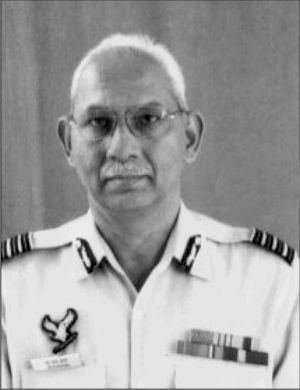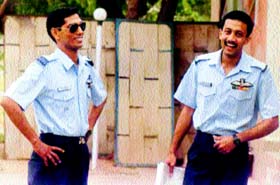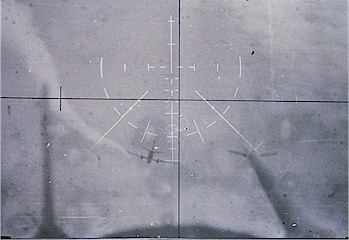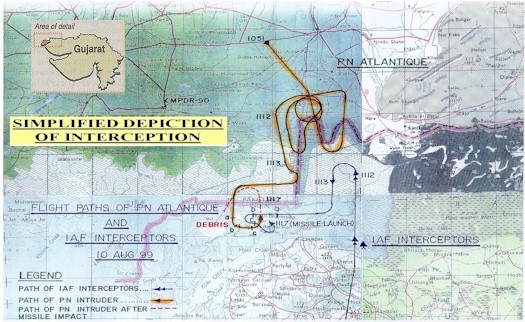Group Captain V S Sharma 14490 ADM (Retd) was the Fighter Controller at Naliya on 10th August 1999. This is his story of the eventful day that resulted in the first air to air interception and shoot down in over 28 years.
 Group Captain V S Sharma 14490 ADM (Retd) was the Fighter Controller at Naliya on 10th August 1999. This is his story of the eventful day that resulted in the first air to air interception and shoot down in over 28 years.
Group Captain V S Sharma 14490 ADM (Retd) was the Fighter Controller at Naliya on 10th August 1999. This is his story of the eventful day that resulted in the first air to air interception and shoot down in over 28 years.
10 August 2019 happens to be the 20th Anniversary of Historic Day in the History of Indian Air Force, when an Air Defence Controller took the momentous decision to identify an Intruder Fixed Wing Military Aircraft, a Pakistan Naval Atlantique, Hostile after Visual Identification followed by orders to shoot down the Intruder.
I can distinctly remember that day as a holiday without fighter flying activity, preparing the Station for planned visit of the Chief of the Indian Air Force, Air Chief Marshall AY Tipnis to fly in a MiG 21 in the Shadow of Moon on the next day, the day of Total Solar Eclipse. We had organised a SHRAMDAAN to clean up the Unit Surroundings.
Around five minutes past Eleven, I heard two fighters taking off. I immediately realized that the situation is live with Fighter Mission scrambled for some activity across the IB. I also knew that Ashu, a youngster with just three months experience as fully Ops controller is alone on duty. I immediately ran to the Cabin. It was an anticipatory scramble by ADDC. I immediately relieved Ashu and asked him to go to the CRC and handle the communications from there. Meanwhile, the mission as per Scramble Order had been ordered to climb to six km (~20,000 ft) and head North. Two ways RT contact couldn’t be established on the main RT channel and Mission was being vectored by DC initially.

Sqn Ldr P.K. Bundela (left) of No.45 Squadron and Fg. Off. S. Narayanan (right) at a press conference after the incident. Sqn. Ldr. Bundela fired the R-60 missile that downed the Atlantique. Fg Offr Narayanan spotted the aircraft first.
Subsequently, two ways RT contact was established on Standby GU RT Set and the mission was controlled on Standby RT. Once Two ways RT contact was established, I asked the Mission to descend to 500 M to avoid pickup by PAF Radars. However, Bandy, the Mission Leader, late Bundela, informed that the sky was under cast with cloud top at two km. Meanwhile, the target Aircraft had gone back to GHA after the first intrusion close to the Northern boundary of the RANN OF KUTCH. The Target Parameters were, Height 2.1km (approx 7000 ft AGL), Speed 360 kmph (~220mph) in a left turn. I kept taking Fighters northwards maintaining them more than ten km East of the North South section of IB. My aim was establish Combat Air Patrol in the Area for a subsequent intrusion.
The Mission was still on a Northerly heading when the Target intruded second time, this time on heading 220 close Northern corner of IB threatening to cross the Southern Section of IB close to Sea. I felt cheated as I had to turn Right, away from the intruder, to get the fighters towards the area of third possible intrusion. I asked the Mission to Head towards general area Koteshwar. This time I decided to keep the Mission about twenty km south of the Southern section of IB. I ordered Mission turn Right on 270 and gave the target position as 1’O Clock 40 Km. To my utter Surprise, Nanu called out contact with a black speck moving against the background of white clouds, that we had learnt as MATTRESS in C&R School. I informed the Mission that the target was still in GHA. He should go in for visual identification while maintaining westerly heading.
Nanu, number two, identified the Target as Pakistan Naval Atlantique as it crossed the IB on a southerly heading. At this stage all the blips had merged into one. Meanwhile, Nanu gained height to keep Bandy’s tail clear while Bandy kept closing in to a distance close enough to call out the tail markings of the intercepted aircraft. At this stage, the intruder was about ten km South of the IB on a steady Easterly Heading 090. I asked Bandy if he was still in contact with Target to which his response was affirmative. At this stage my response was, “Target well inside our Border, identified Hostile, clear to engage.”
My order to engage surprised Bandy who rechecked if he has my clearance to open fire to which my response was affirmative.
As Bandy had dropped his speed to close to 300 kmph, well below the minimum speed for missile launch. It took him almost a minute to achieve the firing parameters. I was relieved to hear from Bandy, “MISSILE GONE, LEFT ENGINE ON FIRE, BREAKING OFF 120.” The real tense moments for me were after the Mission had broken off after shooting down while Atlantique was still flying on single engine in a shallow left turn. I asked Bandy if he can see the Aircraft. His response was that he can see smoke rising through the cloud top while the Atlantique aircraft isn’t visible being under clouds.

The final moments as the R-60 streaks towards the Atlantique – captured in this still photo taken from the HUD/VTR recording from the MiG-21. Photo Courtesy: Indian Air Force
I informed PAJ, the Station Commander, whose immediate response was to drive himself to my Unit at breakneck speed without waiting for driver. He was with me while I was waiting for Tester Masters, the SASO SWAC, to come on line. SASO conveyed GOOD SHOW from the Air Chief before asking me my version of the incident. He asked me if the Mission has landed to which my response was it’s yet to land. While I was recovering the mission, he asked PAJ to move to ORP alongwith me for further debrief.
This is the story that I can recollect today. I will be failing in my duty to appreciate the fine-tuned radar provided by the technical team that helped me mark the crash site and subsequently guide the helicopter to the crash site same evening to pickup the evidence. During subsequent controlled missions next day, I used have RT fade out even while aircraft pickup used to be there at low level.
Few key timings are
Initial Pickup 1052,
Anticipatory Scramble 1101,
Take Off 1105,
Initial Contact as black speck 1114,
Visual identified Atlantique 1116,
Identified Hostile with Orders to engage 1117,
Actual Shooting 1118,
Crash time 1123.

A composite map showing the flight paths of the intruder and the
intercepting aircraft. This was released by the Indian Air Force.
Gp Capt V S Sharma 14490 was awarded the Vayusena Medal (Gallantry) for the succesful direction. This was the first combat VM award to a Fighter Controller Officer since the 1971 war.